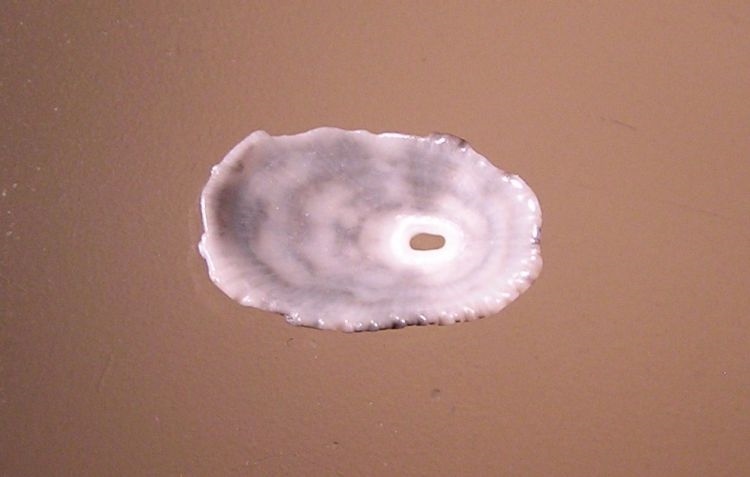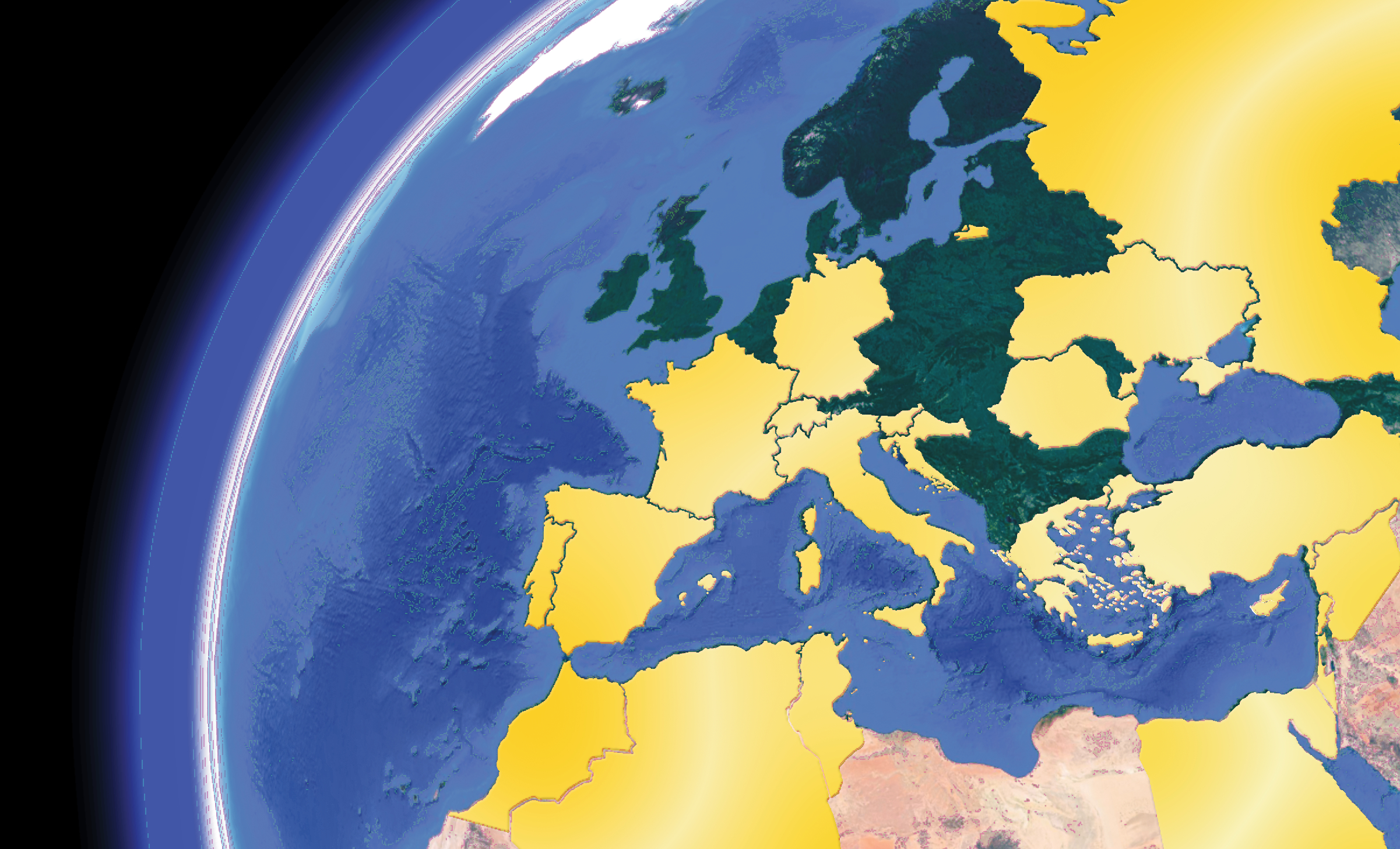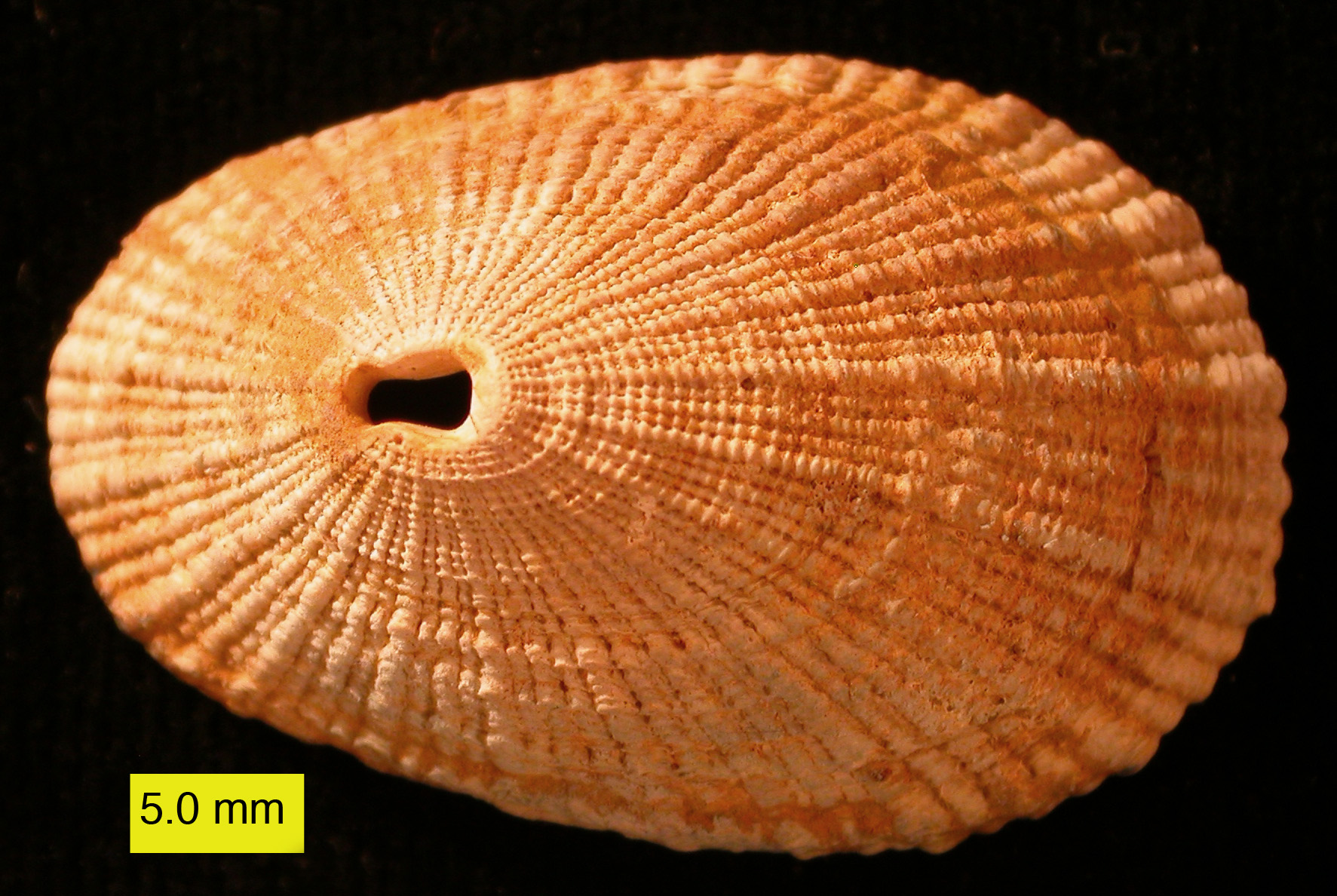|
Diodora Ruepellii
''Diodora rueppellii'', common name the Rüppell's keyhole limpet, is a species of sea snail, a marine gastropod mollusc in the family Fissurellidae, the keyhole limpets. Description ''Diodora ruppellii'' has a shell with a whitish exterior marked with a radial pattern of dark blotches and a white interior surface marked with a faint pattern similar to the exterior. The shell is asteeply conical, elongated oval with a hole at the apex, which is roughly a third of the length of the shell from its anterior end. There are 20 to 25 radiating ribs on the exterior surface of the shell with some smaller ribs between them; the growth ridges are not as developed as the ribs and form knobs at where they intersect. The edges of the apical hole have conspicuous crenulations where they meet the ribs, the notches between the crenulations continue a short distance towards the inside of the shell. The shell can be up to 20 mm long, although 15mm is the most common length, and 10 mm h ... [...More Info...] [...Related Items...] OR: [Wikipedia] [Google] [Baidu] |
George Brettingham Sowerby I
George Brettingham Sowerby I (12 August 1788 – 26 July 1854) was a British naturalist, illustrator and conchologist. Life He was the second son of James Sowerby. George was educated at home under private tutors, and afterwards assisted his father in the production of illustrated works on natural history. On the latter's death in 1822, he and his brother James De Carle Sowerby continued their father's work on fossil shells, publishing the latter parts of the ''Mineral Conchology of Great Britain''. He published about 50 papers on molluscs and started several comprehensive, illustrated books on the subject, the most important the ''Thesaurus Conchyliorum'', a work that was continued by his son, George Brettingham Sowerby II and his grandson George Brettingham Sowerby III. One of his first works was the cataloguing of the collection of the Earl of Tankerville. He also dealt in shells and natural history objects, his place of business being first in King Street, Covent Garden, ... [...More Info...] [...Related Items...] OR: [Wikipedia] [Google] [Baidu] |
Mollusc
Mollusca is the second-largest phylum of invertebrate animals after the Arthropoda, the members of which are known as molluscs or mollusks (). Around 85,000 extant species of molluscs are recognized. The number of fossil species is estimated between 60,000 and 100,000 additional species. The proportion of undescribed species is very high. Many taxa remain poorly studied. Molluscs are the largest marine phylum, comprising about 23% of all the named marine organisms. Numerous molluscs also live in freshwater and terrestrial habitats. They are highly diverse, not just in size and anatomical structure, but also in behaviour and habitat. The phylum is typically divided into 7 or 8 taxonomic classes, of which two are entirely extinct. Cephalopod molluscs, such as squid, cuttlefish, and octopuses, are among the most neurologically advanced of all invertebrates—and either the giant squid or the colossal squid is the largest known invertebrate species. The gastropods ... [...More Info...] [...Related Items...] OR: [Wikipedia] [Google] [Baidu] |
Hawaii
Hawaii ( ; haw, Hawaii or ) is a state in the Western United States, located in the Pacific Ocean about from the U.S. mainland. It is the only U.S. state outside North America, the only state that is an archipelago, and the only state geographically located within the tropics. Hawaii comprises nearly the entire Hawaiian archipelago, 137 volcanic islands spanning that are physiographically and ethnologically part of the Polynesian subregion of Oceania. The state's ocean coastline is consequently the fourth-longest in the U.S., at about . The eight main islands, from northwest to southeast, are Niihau, Kauai, Oahu, Molokai, Lānai, Kahoolawe, Maui, and Hawaii—the last of these, after which the state is named, is often called the "Big Island" or "Hawaii Island" to avoid confusion with the state or archipelago. The uninhabited Northwestern Hawaiian Islands make up most of the Papahānaumokuākea Marine National Monument, the United States' largest protected ... [...More Info...] [...Related Items...] OR: [Wikipedia] [Google] [Baidu] |
KwaZulu-Natal
KwaZulu-Natal (, also referred to as KZN and known as "the garden province") is a province of South Africa that was created in 1994 when the Zulu bantustan of KwaZulu ("Place of the Zulu" in Zulu) and Natal Province were merged. It is located in the southeast of the country, with a long shoreline on the Indian Ocean and sharing borders with three other provinces and the countries of Mozambique, Eswatini and Lesotho. Its capital is Pietermaritzburg, and its largest city is Durban. It is the second-most populous province in South Africa, with slightly fewer residents than Gauteng. Two areas in KwaZulu-Natal have been declared UNESCO World Heritage Sites: the iSimangaliso Wetland Park and the uKhahlamba Drakensberg Park. These areas are extremely scenic as well as important to the surrounding ecosystems. During the 1830s and early 1840s, the northern part of what is now KwaZulu-Natal was established as the Zulu Kingdom while the southern part was, briefly, the Boer Natalia Repu ... [...More Info...] [...Related Items...] OR: [Wikipedia] [Google] [Baidu] |
Indo-Pacific
The Indo-Pacific is a vast biogeographic region of Earth. In a narrow sense, sometimes known as the Indo-West Pacific or Indo-Pacific Asia, it comprises the tropical waters of the Indian Ocean, the western and central Pacific Ocean, and the seas connecting the two in the general area of Indonesia. It does not include the temperate and polar regions of the Indian and Pacific oceans, nor the Tropical Eastern Pacific, along the Pacific coast of the Americas, which is also a distinct marine realm. The term is especially useful in marine biology, ichthyology, and similar fields, since many marine habitats are continuously connected from Madagascar to Japan and Oceania, and a number of species occur over that range, but are not found in the Atlantic Ocean. The region has an exceptionally high species richness, with the world's highest species richness being found in at its heart in the Coral Triangle, and a remarkable gradient of decreasing species richness radiating outward in al ... [...More Info...] [...Related Items...] OR: [Wikipedia] [Google] [Baidu] |
Mediterranean Science Commission
The Mediterranean Science Commission, or CIESM, (French: ''Commission Internationale pour l'Exploration Scientifique de la Méditerranée'') unites 24 Member States, hundreds of marine Institutes, and thousands of marine researchers from all shores of the Basin and adjacent seas, to exchange on the latest advances in oceanography. Created by an International Conference held in Madrid, Spain, in November 1919 the Commission promotes multilateral international research on marine sciences via the international use of national research stations and scientific exchange. Originally the organization was restricted to countries bordering the Mediterranean and the Black seas and is now open to other countries engaged in marine research in the broad region. Early years Two professors, the Italian Decio Vinciguerra and the German Otto Krümmel, thought it would be useful for the fishing industry to promote oceanographic exploration of the Mediterranean Sea. Based on Vinciguerra's prop ... [...More Info...] [...Related Items...] OR: [Wikipedia] [Google] [Baidu] |
Fissurellidae
Fissurellidae, common name the keyhole limpets and slit limpets, is a taxonomic family of limpet-like sea snails, marine gastropod molluscs in the clade Vetigastropoda.Rosenberg, G. (2012). Fissurellidae. Accessed through: World Register of Marine Species at http://www.marinespecies.org/aphia.php?p=taxdetails&id=111 on 2013-01-02 Their common name derives from the small hole in the apex of their cone-like shells. Although superficially resembling "true" limpets, they are in fact not closely related to them. Distribution The distribution of fissurellids is worldwide, from cold waters to tropical waters. Powell A. W. B., ''New Zealand Mollusca'', William Collins Publishers Ltd, Auckland, New Zealand 1979 Habitat Fissurellids live in habitats on and under rocks in the lower intertidal zones to deeper waters. Shell description Keyhole limpets somewhat resemble true limpets because of the simple conical shape of their shells, but in reality they are not closely related to true ... [...More Info...] [...Related Items...] OR: [Wikipedia] [Google] [Baidu] |
Family (biology)
Family ( la, familia, plural ') is one of the eight major hierarchical taxonomic ranks in Linnaean taxonomy. It is classified between order and genus. A family may be divided into subfamilies, which are intermediate ranks between the ranks of family and genus. The official family names are Latin in origin; however, popular names are often used: for example, walnut trees and hickory trees belong to the family Juglandaceae, but that family is commonly referred to as the "walnut family". What belongs to a family—or if a described family should be recognized at all—are proposed and determined by practicing taxonomists. There are no hard rules for describing or recognizing a family, but in plants, they can be characterized on the basis of both vegetative and reproductive features of plant species. Taxonomists often take different positions about descriptions, and there may be no broad consensus across the scientific community for some time. The publishing of new data and opini ... [...More Info...] [...Related Items...] OR: [Wikipedia] [Google] [Baidu] |
Gastropod
The gastropods (), commonly known as snails and slugs, belong to a large taxonomic class of invertebrates within the phylum Mollusca called Gastropoda (). This class comprises snails and slugs from saltwater, from freshwater, and from land. There are many thousands of species of sea snails and slugs, as well as freshwater snails, freshwater limpets, and land snails and slugs. The class Gastropoda contains a vast total of named species, second only to the insects in overall number. The fossil history of this class goes back to the Late Cambrian. , 721 families of gastropods are known, of which 245 are extinct and appear only in the fossil record, while 476 are currently extant with or without a fossil record. Gastropoda (previously known as univalves and sometimes spelled "Gasteropoda") are a major part of the phylum Mollusca, and are the most highly diversified class in the phylum, with 65,000 to 80,000 living snail and slug species. The anatomy, behavior, feeding, and re ... [...More Info...] [...Related Items...] OR: [Wikipedia] [Google] [Baidu] |
Lovell Augustus Reeve
Lovell Augustus Reeve (19 April 1814 – 18 November 1865) was an English conchologist and publisher. Life Born at Ludgate Hill, London, on 19 April 1814, he was a son of Thomas Reeve, draper and mercer, by his wife Fanny Lovell. After attending school at Stockwell, he was apprenticed at the age of 13 to Mr. Graham, a local grocer. The chance of purchase of some shells led to a lifelong interest in conchology. In 1833 he attended the meeting of the British Association for the Advancement of Science at Cambridge. At the end of his apprenticeship Reeve paid a visit to Paris, where he read a paper on the classification of Mollusca before the Academy of Sciences. On his return to London, he set to work on his first book, ''Conchologia Systematica'' (2 vols. London, 1841–2). From 1842, he traded as a natural history dealer. Using profits made by the sale of Dutch Governor-General of the Moluccas Van Ryder's collection from the Moluccas, which he purchased at Rotterdam, and with t ... [...More Info...] [...Related Items...] OR: [Wikipedia] [Google] [Baidu] |
Sea Snail
Sea snail is a common name for slow-moving marine gastropod molluscs, usually with visible external shells, such as whelk or abalone. They share the taxonomic class Gastropoda with slugs, which are distinguished from snails primarily by the absence of a visible shell. Definition Determining whether some gastropods should be called sea snails is not always easy. Some species that live in brackish water (such as certain neritids) can be listed as either freshwater snails or marine snails, and some species that live at or just above the high tide level (for example species in the genus '' Truncatella'') are sometimes considered to be sea snails and sometimes listed as land snails. Anatomy Sea snails are a very large group of animals and a very diverse one. Most snails that live in salt water respire using a gill or gills; a few species, though, have a lung, are intertidal, and are active only at low tide when they can move around in the air. These air-breathing species includ ... [...More Info...] [...Related Items...] OR: [Wikipedia] [Google] [Baidu] |
Species
In biology, a species is the basic unit of classification and a taxonomic rank of an organism, as well as a unit of biodiversity. A species is often defined as the largest group of organisms in which any two individuals of the appropriate sexes or mating types can produce fertile offspring, typically by sexual reproduction. Other ways of defining species include their karyotype, DNA sequence, morphology, behaviour or ecological niche. In addition, paleontologists use the concept of the chronospecies since fossil reproduction cannot be examined. The most recent rigorous estimate for the total number of species of eukaryotes is between 8 and 8.7 million. However, only about 14% of these had been described by 2011. All species (except viruses) are given a two-part name, a "binomial". The first part of a binomial is the genus to which the species belongs. The second part is called the specific name or the specific epithet (in botanical nomenclature, also sometimes i ... [...More Info...] [...Related Items...] OR: [Wikipedia] [Google] [Baidu] |










.jpg)
